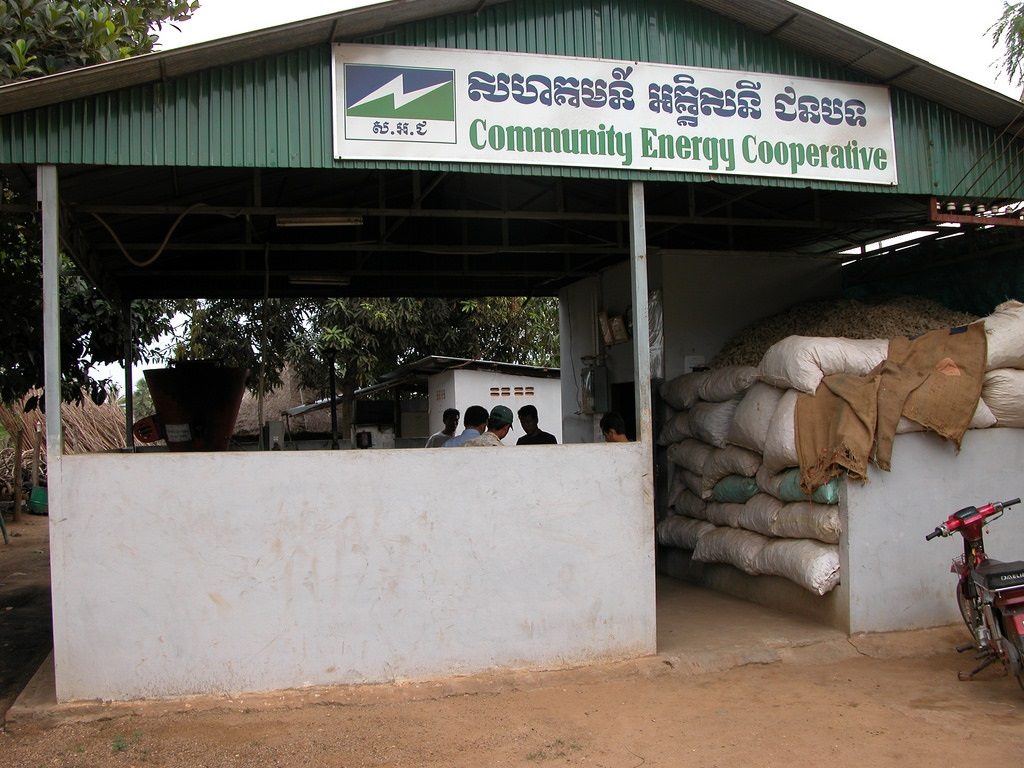
សហគមន៍អគ្គិសនីជនបទក្នុងប្រទេសកម្ពុជា។ រូបភាព ដោយ Nomade Moderne, ថតនៅថ្ងៃទី ២៣ ខែ មីនា ឆ្នាំ ២០០៦។ ក្រោមអាជ្ញាប័ណ្ណ CC BY-NC-ND
អគ្គិសនីដែលបានចែកចាយនៅកម្ពុជា គឺមួយផ្នែកបានមកពីការផលិតនៅក្នុងស្រុក និងមួយផ្នែកទៀតត្រូវបាននាំចូល។ អស់រយៈពេលជាច្រើនឆ្នាំហើយ ការផលិតថាមពលនៅក្នុងស្រុកជាទូទៅជាការផលិតខ្នាតតូច ហើយភាគច្រើនបានមកពីការផលិតដោយចំហេះម៉ាស៊ូត និងប្រេង ខណៈដែលអគ្គិសនីនាំចូលពីប្រទេសជិតខាងមានចំនួនច្រើនសម្រាប់ការផ្គត់ផ្គង់ស្ទើរតែទាំងអស់។ មានការចែកចាយតិចតួចនៅតាមតំបន់ដែលនៅក្រៅតំបន់ទីក្រុងធំៗ។ បច្ចុប្បន្ននេះ តួលេខនៃផលិត នាំចូល និងចែកចាត កំពុងប្រែប្រួលយ៉ាលឿន។ ប្រទេសកម្ពុជា គឺកំពុងផលិតអគ្គិសនីដោយខ្លួនឯងបានកាន់តែច្រើនឡើង ពីទំនប់វារីអគ្គិសនី និងរោងចក្រថាមពលដើរដោយចំហេះធ្យូងថ្ម។
រាជធានីភ្នំពេញនៃព្រះរាជាណាចក្រកម្ពុជា ប្រើប្រាស់ ៩០ភាគរយ នៃអគ្គិសនីសម្រាប់ផ្គត់ផ្គង់ទូទាំងប្រទេស។ យ៉ាងណាមិញ ការចែកចាយទៅកាន់តំបន់ជនបទ គឺកំពុងកើនឡើងយ៉ាងឆាប់រហ័ស។ នៅក្នុងឆ្នាំ ២០១០ មានភូមិប្រមាណ ២៩ភាគរយ បានភ្ជាប់បណ្តាញអគ្គិសនី ហើយនៅពាក់កណ្តាលឆ្នាំ ២០១៥ ចំនួននេះបានកើនឡើងជាងទ្វេដង រហូតដល់ ៦២ភាគរយ នេះបើយោងតាមទិន្នន័យពីក្រសួងរ៉ែ និងថាមពល។1 ភូមិទាំងអស់ត្រូវបានរំពឹងថា នឹងបានភ្ជាប់បណ្តាញអគ្គិសនីនៅត្រឹមឆ្នាំ ២០២០ ប៉ុន្តែនៅមានប្រមាណ ៨២០,០០០ គ្រួសារ ឬស្មើនឹងប្រជាជន ៤ លាននាក់ ដែលនៅមិនទាន់រំពឹងថានឹងបានតភា្ជប់បណ្តាញអគ្គិសនីជាតិរហូតដល់ឆ្នាំ ២០៣០ យ៉ាងឆាប់។2
តម្រូវការអគ្គិសនីប្រចាំឆ្នាំត្រូវបានរំពឹងថានឹងកើនឡើងរហូតដល់ ១៧.៩ភាគរយ ចាប់តាំងពីឆ្នាំ ២០១២ ដល់ឆ្នាំ ២០២០3 ដោយសារកំណើនផលិតកម្មឧស្សាហកម្ម កំណើនប្រជាជន និងការកើនឡើងស្តង់ដារនៃការរស់នៅ។ ជាក់ស្តែង កំណើនពិតប្រាកដ បានបង្ហាញឃើញថាខ្ពស់ជាងនេះ នៅប្រមាណជា ២០ភាគរយ ក្នុងមួយឆ្នាំ និងនៅតែបន្តកើនឡើងទៀត។4
អគ្គិសនី គឺមានតម្លៃថ្លៃបើប្រៀបធៀបទៅនឹងបណ្តាប្រទេសផ្សេងទៀតនៅក្នុងតំបន់អាស៊ី។ នៅកន្លែងខ្លះ ការបញ្ចុះតម្លៃត្រូវបានចរចារដើម្បីទាក់ទាញការវិនិយោគពីបរទេសនៅក្នុងវិស័យឧស្សាហកម្មផលិតកម្ម។ ជាឧទាហរណ៍ នៅតំបន់សេដ្ឋកិច្ចពិសេសភ្នំពេញ អត្រាតម្លៃអគ្គិសនី ២៩សេន (ដុល្លារ) ក្នុងមួយគីឡូវ៉ាតម៉ោង ត្រូវបានរាយការណ៍ថាបានកាត់បន្ថយនៅត្រឹមតែ ២១សេន ហើយវាចុះទៅនៅត្រឹម ១៨ សេន។5
ការផលិតអគិ្គសនី
អគ្គិសនីនៅកម្ពុជាត្រូវបានផលិតដោយ៖
- អគ្គិសនីកម្ពុជា (EDC) ជាក្រុមហ៊ុនរបស់រដ្ឋ។ អគ្គិសនីកម្ពុជាបានទទួលអាជ្ញាប័ណ្ណសម្រាប់ការផលិត និងការចែកចាយអគ្គិសនីនៅក្នុងទីក្រុងភ្នំពេញ និងខេត្តក្រុងចំនួន ១២ ទៀត
- ស្ថាប័នឯកជន រួមទាំងអ្នកផលិតអគ្គិសនីឯករាជ្យនានានៅតាមទីប្រជុំជនក្នុងខេត្តនានា
- អ្នកទទួលអាជ្ញាប័ណ្ណនៅតាមតំបន់ប្រជុំជនតូចៗ
- សហគ្រាសអគ្គិសនីនៅតាមទីជនបទ។
ថាមពលដែលបានផលិត និងបញ្ជូនចែកចាយ ដោយអ្នកទទួលបានអាជ្ញាប័ណ្ណទាំងអស់នៅក្នុងប្រទេសកម្ពុជាអំឡុងឆ្នាំ ២០១៤ មានចំនួន ៣,០៥៨ ជីឡូវ៉ាត់ម៉ោង (GWh) ដែលត្រូវជា ៧៣ភាគរយ ច្រើនជាងថាមពលដែលបានបញ្ជូនចែកចាយនៅអំឡុងឆ្នាំ ២០១៣។6
អគ្គិសនីត្រូវបានផលិតស្ទើរតែទាំងស្រុងពីស្ថានីយ៍វារីអគ្គិសនី (៦០ភាគរយ), ពីរោងចក្រថាមពលដើរដោយចំហេះធ្យូងថ្មនៅខេត្តព្រះសីហនុ (២៨ភាគរយ), និងរោងចក្រថាមពលដើរដោយចំហេះម៉ាសូត ឬប្រេង (១២ភាគរយ)។
ស្ថានីយ៍វារីអគ្គិសនីចំនួន ៨ ដែលកំពុងតែដំណើរការ មានដូចជា៖ ស្ថានីយ៍គិរីរម្យ១, ស្ថានីយ៍គិរីរម្យ៣, ស្ថានីយ៍កំចាយ, ស្ថានីយ៍ស្ទឹងអាតៃ, ស្ថានីយ៍ស្ទឹងឬស្សីជ្រុំក្រោម, និងស្ថានីយ៍ស្ទឹងតាតៃ ដែលស្ថានីយ៍ទាំងអស់នេះត្រូវបានភ្ជាប់ទៅនឹងស្ថានីយ៍តំឡើងតង់ស្យុងជាតិទាំងអស់ ក្នុងនោះមាន ខេត្តរតនគិរី (ភ្ជាប់ទៅនឹងប្រព័ន្ធថាមពលរបស់អគ្គិសនីកម្ពុជាខេត្តរតនគិរី) និងខេត្តមណ្ឌលគិរី (ភ្ជាប់ទៅនឹងប្រព័ន្ធថាមពលរបស់អគ្គិសនីកម្ពុជាខេត្តមណ្ឌលគិរី)។7 ការផលិតអគិ្គសនីថ្មីពីស្ថានីយ៍ស្ទឹងតាតៃ និងការផលិតបន្ថែមទៀតពីស្ថានីយ៍ស្ទឹងឬស្សីជ្រុំក្រោម បានបង្ហាញថា ថាមពលដែលបានផលិតដោយស្ថានីយ៍វារីអគ្គិសនីនៅឆ្នាំត្រឹមឆ្នាំ ២០១៤ (១៨៥១.៦០ លានគីឡូវ៉ាតម៉ោង) ត្រូវជា ៥៤% ខ្ពស់ជាងការផលិតកាលពីចុងឆ្នាំ ២០១៣។8
នៅក្នុងរបាយការណ៍ឆ្នាំ ២០១៥ អាជ្ញាធរអគ្គិសនីកម្ពុជា បានកត់សម្គាល់ឃើញថា គម្រោងនានាស្ថិតនៅក្រោមការសាងសង់នៅឡើយដែលរួមទាំងរោងចក្រថាមពលដើរដោយចំហេះធ្យូងថ្ម ដែលមានទំហំផលិត ១៣៥ មេហ្គាវ៉ាត់ នៅក្នុងខេត្តព្រះសីហនុ ដោយសារតែគម្រោងនេះត្រូវបានអនុញ្ញាតឱ្យដំណើរការនៅក្នុងឆ្នាំ ២០១៧ និងទំនប់វារីអគ្គិសនី ទំហំ ៤០០ មេហ្គាវ៉ាត់ នៅសេសានក្រោម២ ផងដែរ។
ការផលិតថាមពលក្នុងទម្រង់ផ្សេងទៀតហាក់នៅមានកម្រិតនៅឡើយ ទោះបីជាការសិក្សាមួយនៅក្នុងឆ្នាំ ២០១៦ បានបង្ហាញថា ការចែកចាយថាមពលបំលែងពីពន្ធឺព្រះអាទិត្យ គឺកំពុងមានការប្រកួតប្រជែងជាមួយនឹងការផលិតដោយម៉ាស៊ីនម៉ាសូតនាពេលបច្ចុប្បន្ននេះនៅកម្ពុជា បើទោះជាតម្លៃប្រេងម៉ាស៊ូតនៅត្រឹមកម្រិតទាបបំផុតក្នុងរយៈពេលប៉ុន្មានឆ្នាំនេះក៏ដោយ។9
មូលនិធិអគ្គិសនីភាវូបនីយកម្មជនបទ ត្រូវបានបង្កើតឡើងនៅឆ្នាំ ២០០៤ ដើម្បីជួយផ្តល់ការទទួលបានអគ្គិសនីប្រើប្រាស់ដោយសមភាព។ មូលនិធិនេះផ្តល់ជំនួយឥតសំណងសម្រាប់ការអភិវឌ្ឍប្រព័ន្ធថាមពលពន្លឺព្រះអាទិត្យតាមផ្ទះ និងប្រព័ន្ធផលិតវារីអគ្គិសនីខ្នាតតូចបំផុត និងខ្នាតតូចផងដែរ។
អគ្គិសនីនាំចូល
នៅក្នុងឆ្នាំ ២០១៥ កម្ពុជាបានប្រើប្រាស់អគ្គិសនីចំនួន ១,៩៨៥ មេហ្គាវ៉ាត់ ដែល ១,៥៦៩ មេហ្គាវ៉ាត់ ត្រូវបានផលិតនៅក្នុងស្រុក។ អគ្គិសនីបាននាំចូលពីប្រទេសវៀតណាម (២៧៧ មេហ្គាវ៉ាត់), ប្រទេសថៃ (១៣៥.៥ មេហ្គាវ៉ាត់) និងប្រទេសឡាវ (៤ មេហ្គាវ៉ាត់)។10
អគ្គិសនីពីវៀតណាម ត្រូវបានបញ្ជូនតាមខ្សែបណ្តាញតង់ស្យុងខ្ពស់ទៅកាន់ទីក្រុងភ្នំពេញ ចំណែកឯអគ្គិសនីនាំមកពីប្រទេសថៃ បញ្ជូនតាមខ្សែឆ្លងកាត់បណ្តាខេត្តបន្ទាយមានជ័យ បាត់ដំបង និងខេត្តសៀមរាប។ អគ្គិសនីនាំចូលពីប្រទេសឡាវ គឺសម្រាប់ផ្គត់ផ្គង់ក្នុងតំបន់នានានៃខេត្តស្ទឹងត្រែង។
ការចែកចាយអគ្គិសនី
គម្រោងធំៗសំដៅពង្រីកបណ្តាញចែកចាយ កំពុងដំណើរការឆ្ពោះទៅសម្រេចគោលដៅនៃផែនការយុទ្ធសាស្ត្រអភិវឌ្ឍន៍ជាតិ ដែលនឹងបន្ថែមប្រវែងខ្សែបញ្ជូនអគ្គិសនីតង់ស្យុងខ្ពស់ ១២,៨០០ គីឡូម៉ែតទៀត ទៅកាន់បណ្តាញចែកចាយនៅត្រឹមឆ្នាំ ២០១៨។11
មានហេតុផលចំនួនពីរ នៅពីក្រោយនៃតម្រូវការបន្ថែមខ្សែបញ្ជូនអគ្គិសនីតង់ស្យុងខ្ពស់៖ បញ្ជូនឲ្យទៅដល់ភូមិនានាដែលមិនទាន់បានភ្ជាប់ជាមួយបណ្តាញជាតិ និងភ្ជាប់ពីស្ថានីយ៍ផលិតថ្មីៗទៅកាន់អ្នកប្រើប្រាស់។ ជាឧទាហរណ៍៖ ខ្សែបណ្តាញមួយដែលមានតម្លៃ ៩២ លានដុល្លារនឹងត្រូវបានសាងសង់ ដើម្បីភ្ជាប់អគ្គិសនីពីស្ថានីយ៍វារីអគ្គិសនីសេសានក្រោម២ក្នុងខេត្តស្ទឹងត្រែងទៅកាន់ខេត្តកំពង់ចាម និងខេត្តក្រចេះ។12
ខណៈដែលការចែកចាយបានកំពុងរីកចម្រើនយ៉ាងឆាប់រហ័ស តែនេះគឺជាដំណើរការដែលត្រូវចំនាយថវិកាច្រើន។ អគ្គនាយកនៃអគ្គិសនីកម្ពុជា លោក ទី នរិន្ទ ត្រូវបានដកស្រង់សម្តីថា ការធ្វើអគ្គិសនីភាវូបនីយកម្មទាំងស្រុងនៅទូទាំងប្រទេសកម្ពុជា អាចនឹងចំនាយថវិកាជិត ១ប៊ីលានដុលា្លរ។13
គម្រោងចែកចាយជាទូទៅទាមទារឱ្យមានការគាំទ្រមូលនិធិពីខាងក្រៅ។ គម្រោងខ្លះត្រូវបានអនុវត្តក្រោមទម្រង់ជាការបណ្តាក់ទុនរួមគ្នា។ ជាឧទាហរណ៍៖ ការអភិវឌ្ឍក្នុងតម្លៃ ២៣.៩ លានដុល្លារ ដែលបាននាំបណ្តាញបញ្ជូនអគិ្គសនីជាតិឱ្យដល់ប្រជាជនប្រមាណ ៣១,០០០ គ្រួសារ (១៥០,០០០នាក់) ទូទាំងខេត្តតាកែវ កំពត និងកំពង់ស្ពឺ នៅក្នុងឆ្នាំ ២០១៥ គឺការបណ្តាក់ទុនរួមគ្នា។ ធនាគារអភិវឌ្ឍន៍របស់អាល្លឺម៉ង់ (Kfw) បានចូលរួមចំណែកទឹកប្រាក់ ២២.២ លានដុល្លារ ហើយភាគីរដ្ឋាភិបាលកម្ពុជា តាមរយៈអគ្គិសនីកម្ពុជា បង់លើចំណែកដែលនៅសល់។14
គម្រោងផ្សេងទៀត ដំណើរការតាមគំរូកិច្ចសន្យា សាងសង់-អាជីវកម្ម-ផ្ទេរ (BOT) ដែលក្រុមហ៊ុនមកពីខាងក្រៅសាងសង់ និងធ្វើប្រតិបត្តិការលើសំណង់នោះ ដែលនឹងត្រូវផ្ទេរឱ្យជាកម្មសិទ្ធិរបស់កម្ពុជាវិញ បន្ទាប់ពីបានដំណើរការរយៈពេលច្រើនឆ្នាំ។ គំរូបែបនេះត្រូវបានដាក់ឲ្យអនុវត្តជាមួយគម្រោងទំនប់វារីអគ្គិសនីរបស់កម្ពុជា ស្ទើរតែទាំងអស់ ប៉ុន្តែវាក៏ត្រូវបានប្រើសម្រាប់គម្រោងចែកចាយផងដែរ។ ឧទាហរណ៍៖ ខ្សែបណ្តាញតង់ស្យុងខ្ពស់មួយទំហំ ២៣០ គីឡូវ៉ុល ដែលភ្ជាប់ខេត្តក្រចេះ និងកំពង់ចាម គឺកំពុងត្រូវបានអភិវឌ្ឍឡើងក្រោមក្របខណ្ឌកិច្ចសន្យាសាងសង់-អាជីវកម្ម-ផ្ទេរ (BOT) សម្រាប់រយៈពេល ២៥ឆ្នាំ។15
គោលនយោបាយ និងអភិបាលកិច្ច
តាមឯកសារនៃគោលនយោបាយស្នូលរបស់រាជរដ្ឋាភិបាល យុទ្ធសាស្ត្រចតុកោណឆ្នាំ ២០១៣ និងផែនការយុទ្ធសាស្ត្រអភិវឌ្ឍន៍ជាតិ ២០១៤-២០១៨ បានដាក់ចេញនូវអាទិភាពជុំវិញការពង្រីកការផលិតអគ្គិសនី និងការពង្រីកខ្សែបណ្តាញតង់ស្យុងខ្ពស់គ្រប់កម្រិតថ្នាក់ដើម្បីពង្រឹងសន្តិសុខថាមពល និងដើម្បីធានាដល់ការផ្គត់ផ្គង់ដែលមានស្ថេរភាព និងមានតម្លៃសមរម្យ និងការចែកចាយអគ្គិសនីដើម្បីការអភិវឌ្ឍ។
ក្នុងការត្រៀមសម្រាប់វេទិកាការប្រែប្រួលអាកាសធាតុទីក្រុងប៉ារីសឆ្នាំ ២០១៥ ប្រទេសកម្ពុជាបានប្តេជ្ញាចិត្តនឹងការកាត់បន្ថយអាំងតង់ស៊ីតេកាបូននៅក្នុងវិស័យថាមពលរបស់ខ្លួន ដែលជាផ្នែកនៃការចូលរួមកំណត់គោលបំណងជាតិរបស់ប្រទេសកម្ពុជា (INIC)។ ប្រទេសកម្ពុជាបានស្នើរ (ជាមួយលក្ខខណ្ឌនៃកិច្ចគាំទ្រអន្តរជាតិ) ការចូលរួមកាត់បន្ថយឧស្ម័នផ្ទះកញ្ចក់ រួមទាំងការកាត់បន្ថយឱ្យបាន ១៦ភាគរយ នៅត្រឹមឆ្នាំ ២០៣០ លើវិស័យពាណិជ្ជកម្មក្នុងវិស័យថាមពលរបស់ប្រទេសនេះ។
ការចូលរួមកំណត់គោលបំណងជាតិ (INDC) សំដៅលើចំណុចអាទិភាពដូចជា៖
- បណ្តាញអគ្គិសនីជាតិដែលភ្ជាប់ទៅនឹងការផលិតថាមពលកកើតឡើងវិញ (ថាមពលព្រះអាទិត្យ, ថាមពលវារីអគ្គិសនី, ជីវម៉ាស និងជីវឧស្ម័ន)
- ការភ្ជាប់វិមជ្ឈការនៃការផលិតថាមពលកកើតឡើងវិញទៅនឹងបណ្តាញជាតិ
- អគ្គិសនីដែលមិនភ្ជាប់ជាមួយបណ្តាញជាតិដូចជា ប្រព័ន្ធពន្លឺព្រះអាទិត្យតាមផ្ទះ វារីអគ្គិសនី (ពីកូ–ក្រោម ៥គីឡូវ៉ាត់, មីនី –ចន្លោះពី ១ ទៅ ២០ មេហ្គាវ៉ាត់, និងមីក្រូ–ពី ៥គីឡូវ៉ាត់ ទៅ ១០០ គីឡូវ៉ាត់) និងការលើកម្ពស់ប្រសិទ្ធិភាពថាមពលសម្រាប់អ្នកប្រើប្រាស់។
អាជ្ញាធរអគ្គិសនីកម្ពុជា គឺជានិយ័តករក្នុងវិស័យថាមពល និងជាអ្នកទទួលខុសត្រូវសម្រាប់ការផ្តល់អាជ្ញាប័ណ្ណ ការអនុម័ត និងការពង្រឹងការអនុវត្តស្តង់ដារ និងការកំណត់ពន្ធ អត្រា និងតម្លៃសម្រាប់អគ្គិសនីផងដែរ។ អាជ្ញាធរផ្តល់អាជ្ញាបណ្ណសម្រាប់ការផលិត ការតខ្សែបណ្តាញតង់ស្យុងខ្ពស់ ការចែកចាយ ការលក់រាយបន្ត ឬអាជ្ញាបណ្ណរួមបញ្ជូលគ្នា។ គេហទំព័ររបស់អាជ្ញាធរនេះ ផ្តល់នូវព័ត៌មានសំបូរបែបលើវិស័យអគ្គិសនីកម្ពុជា រួមទាំងអាជ្ញាបណ្ណថតចម្លងនានា ក្របខណ្ឌគតិយុត្តិ ស្តង់ដាសេវាកម្ម របាយការណ៍ប្រចាំឆ្នាំ និងផែនទីជាដើម។
ក្រសួងរ៉ែ និងថាមពល ទទួលខុសត្រូវសម្រាប់កិច្ចការអភិបាលកិច្ចទូទៅនៅក្នុងវិស័យថាមពល។ ក្រសួងនេះមានតួនាទីអភិវឌ្ឍគោលនយោបាយ និងយុទ្ធសាស្ត្រ គម្រោងអភិវឌ្ឍន៍ថាមពល ដឹកនាំពាណិជ្ជកម្មអគ្គិសនីជាមួយប្រទេសជិតខាង និងពិនិត្យលើគម្រោងអភិវឌ្ឍន៍ធំៗ និងការគ្រប់គ្រងវិស័យអគ្គិសនីភាវូបនីយកម្មជនបទ។ ក្រសួងពាណិជ្ជកម្ម ជាមួយនឹង ក្រសួងរ៉ែ និងថាមពល គឺជាកម្មសិទ្ធិកររួមនៃអគ្គិសនីកម្ពុជា។
អគ្គិសនីកម្ពុជា (EDC) គឺជាស្ថាប័នស្វយ័តមួយដែលមានទំនួលខុសត្រូវសម្រាប់ការផលិត ការបញ្ជូនអគ្គិសនីតាមខ្សែបណ្តាញតង់ស្យុងខ្ពស់ និងការចែកចាយអគ្គិសនីនៅទូទាំងប្រទេសកម្ពុជា។ មុខងារដ៏សំខាន់របស់ស្ថាប័ននេះ គឺកំពុងផ្គត់ផ្គង់អគ្គិសនី អភិវឌ្ឍការតភ្ជាប់ខ្សែបណ្តាញតង់ស្យុងខ្ពស់ និងសម្រួលដល់ការនាំចូល និងនាំចេញអគ្គិសនីទៅកាន់ និងមកពីប្រទេសជិតខាង។
បទប្បញ្ញត្តិសំខាន់ៗនៅក្នុងច្បាប់ស្តីពីអគ្គិសនីឆ្នាំ ២០០១ មានដូចជា៖
- ការពារសិទ្ធិអ្នកប្រើប្រាស់ ដើម្បីទទួលបានការផ្គត់ផ្គង់សេវាកម្មអគ្គិសនីដែលមានស្ថេរភាព និងគ្រប់គ្រាន់តាមតម្លៃសមរម្យ
- ជម្រុញការប្រកួតប្រជែងតាមដែលអាចធ្វើទៅបាន
- បង្កើតអាជ្ញាធរអគ្គិសនីកម្ពុជា ជានិយ័តករក្នុងវិស័យថាមពល
- លើកកម្ពស់លក្ខខណ្ឌអនុគ្រោះសម្រាប់ការវិនិយោគ និងប្រតិបត្តិការពាណិជ្ជកម្មក្នុងវិស័យអគ្គិសនី។
បានធ្វើបច្ចុប្បន្នភាព៖ ២០ ឧសភា ២០១៦
ទាក់ទងនឹងហេដ្ឋារចនាសម្ព័ន្ធអគ្គិសនី
ឯកសារយោង
- 1. WWF និង IES. “ចក្ខុវិស័យវិស័យថាមពល៖ ដំណើរឆ្ពោះទៅរកថាមពលកកើតឡើងវិញ ១០០% នៅឆ្នាំ ២០៥០”។ មហាតំបន់ទន្លេមេគង្គ, របាយការណ៍កម្ពុជា។ WWF៖ ខែឧសភា ឆ្នាំ២០១៦។ ចូលអានថ្ងៃទី ២០ ខែឧសភា ឆ្នាំ២០១៦។ http://awsassets.panda.org/downloads/gmpo_psv_part_1.pdf
- 2. ដូចឯកសារយោងខាងដើម។
- 3. ក្រុមប្រឹក្សាអភិវឌ្ឍន៍កម្ពុជា (CDC). “សៀវភៅមគ្គុទេសន៍ស្តីពីការវិនិយោគនៅកម្ពុជា ២០១៣”។ ចូលអានថ្ងៃទី២៥ ខែវិច្ឆកា ឆ្នាំ ២០១៤។ http://www.cambodiainvestment.gov.kh/#fragment-3-tab,
- 4. WWF និង IES. “ចក្ខុវិស័យវិស័យថាមពល៖ ដំណើរឆ្ពោះទៅរកថាមពលកកើតឡើងវិញ ១០០% នៅឆ្នាំ ២០៥០”។ មហាតំបន់ទន្លេមេគង្គ, របាយការណ៍កម្ពុជា។ WWF៖ ខែឧសភា ឆ្នាំ២០១៦។ ចូលអានថ្ងៃទី ២០ ខែឧសភា ឆ្នាំ២០១៦។ http://awsassets.panda.org/downloads/gmpo_psv_part_1.pdf
- 5. សុខ ចាន់. “រដ្ឋាភិបាលជម្រុញពាណិជ្ជករវិនិយោគក្នុងវិស័យថាមពល”។ កាសែតខ្មែរថាមស៍, ចុះថ្ងៃទី២៥ ខែកុម្ភៈ ឆ្នាំ២០១៦។ ចូលអានថ្ងៃទី ២០ ខែឧសភា ឆ្នាំ២០១៦។https://opendevelopmentcambodia.net/news/govt-urges-business-to-invest-in-power/
- 6. អាជ្ញាធរអគ្គិសនីកម្ពុជា. របាយការណ៍ស្តីពីវិស័យថាមពលនៃព្រះរាជាណាចក្រកម្ពុជា។ រាជធានីភ្នំពេញ៖ អាជ្ញាធរអគ្គិសនីកម្ពុជា, បោះពុម្ភឆ្នាំ២០១៥, ទំព័រ ២៥។ ចូលអានខែឧសភា ឆ្នាំ២០១៦។ http://eac.gov.kh/wp-content/uploads/2015/07/report-2014en.pdf
- 7. ដូចឯកសារយោងខាងដើម, ទំព័រ ២៦។
- 8. ដូចឯកសារយោងខាងដើម។
- 9. WWF និង IES. “ចក្ខុវិស័យវិស័យថាមពល៖ ដំណើរឆ្ពោះទៅរកថាមពលកកើតឡើងវិញ ១០០% នៅឆ្នាំ ២០៥០”។ មហាតំបន់ទន្លេមេគង្គ, របាយការណ៍កម្ពុជា។ WWF៖ ខែឧសភា ឆ្នាំ២០១៦។ ចូលអានថ្ងៃទី ២០ ខែឧសភា ឆ្នាំ២០១៦។ http://awsassets.panda.org/downloads/gmpo_psv_part_1.pd
- 10. សរ ចាន់តារ៉ា. “ក្រុមហ៊ុននានាប្រាប់ថា៖ ដាក់ការខិតខំប្រឹងប្រែងបន្ថែមនៅក្នុងការផ្គត់ផ្គង់ថាមពល”។ កាសែតភ្នំពេញប៉ុស្តិ៍, ចុះថ្ងៃទី ១៩ ខែមករា ឆ្នាំ២០១៦។ ចូលអានថ្ងៃទី ២០ ខែ ឧសភា ឆ្នាំ ២០១៦។ http://www.phnompenhpost.com/business/put-more-energy-power-supply-firms-told
- 11. ក្រសួងផែនការ. “ផែនការយុទ្ធសាស្ត្រអភិវឌ្ឍន៍ជាតិ ២០១៤-២០១៨”, ទំព័រ viii. ចូលអានថ្ងៃទី១៦ ខែកញ្ញា ឆ្នាំ២០១៥។ http://www.mop.gov.kh/Home/NSDP/NSDP20142018/tabid/216/Default.aspx
- 12. ចាន់ មួយហុង. “ខ្សែបណ្តាញតង់ស្យុងខ្ពស់នឹងភ្ជាប់ពីស្ថានីយ៍វារីអគ្គិសនីនៅឆ្នាំ ២០១៧”។ កាសែតភ្នំពេញប៉ុស្តិ៍, ចុះថ្ងៃទី២១ ខែឧសភា ឆ្នាំ២០១៥។ ចូលអានថ្ងៃទី ២០ ខែ ឧសភា ឆ្នាំ ២០១៦។ http://www.phnompenhpost.com/business/transmission-line-connect-dam-2017
- 13. សរ ចាន់តារ៉ា. “ក្រុមហ៊ុននានាប្រាប់ថា៖ ដាក់ការខិតខំប្រឹងប្រែងបន្ថែមនៅក្នុងការផ្គត់ផ្គង់ថាមពល”។ កាសែតភ្នំពេញប៉ុស្តិ៍, ចុះថ្ងៃទី ១៩ ខែមករា ឆ្នាំ២០១៦។ ចូលអានថ្ងៃទី ២០ ខែ ឧសភា ឆ្នាំ ២០១៦។ http://www.phnompenhpost.com/business/put-more-energy-power-supply-firms-told
- 14. ម៉ៃ គុណមករា. “គម្រោងភ្ជាប់បណ្តាញជាតិសម្រាប់ ១៥០,០០០ គ្រួសារ”។ កាសែតភ្នំពេញប៉ុស្តិ៍, ចុះថ្ងៃទី២ ខែមីនា ឆ្នាំ២០១៥។ ចូលអានថ្ងៃទី ២០ ខែឧសភា ឆ្នាំ២០១៦។ http://www.phnompenhpost.com/project-connect-150000-grid
- 15. Cam McGrath. “ក្រុមហ៊ុន ម៉ាឡេស៊ី គ្រោងចុះបញ្ជីក្នុងផ្សារហ៊ុនកម្ពុជា”។ កាសែតភ្នំពេញប៉ុស្តិ៍, ចុះថ្ងៃទី ០១ ខែមីនា ឆ្នាំ២០១៦។ ចូលអានថ្ងៃទី ២០ ខែឧសភា ឆ្នាំ ២០១៦។ http://www.phnompenhpost.com/business/pestech-plugs-power-sector-ahead-listing

